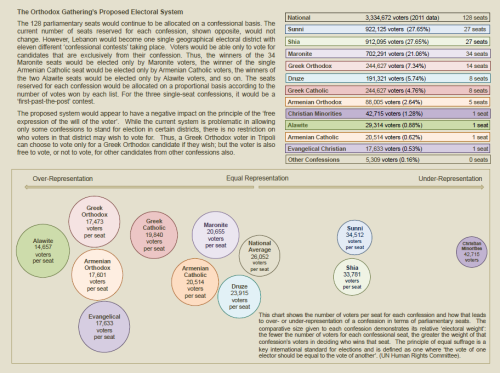

Click HERE to enlarge image
Much has already been said about the very peculiar electoral law proposed by the Orthodox Gathering and endorsed by all of Lebanon’s Maronite leaders. Civil society groups say that it further entrenches sectarianism. Michael Young writes that itdeepens Christian isolation. Meanwhile, Ziyad Baroud is hedging his bets.
My biggest problem with the proposal is very simple: it leads to enormous inequalities of suffrage. What does this mean?
Imagine a country with a parliament divided into quotas based on colors of hair. For example, 20% of the seats are devoted to blond-haired MPs, 35% to redheads, 20% to brown-haired people, 15% to salt-and-pepper, etc.
Once upon a time, this proportional arrangement of seats matched the actual hair-color demographics in the country, but over time, the blonds (who, as a rule, tend to have more fun) multiplied more vigorously than the redheads, while an unfortunate epidemic of male-pattern balding eviscerated the once healthy ranks of the brown-haired.
The redheads, however, are insistent upon maintaining the old quotas, even though demographics have changed. What’s more, they insist that districts should be drawn in such a way as to guarantee that redheaded representatives are elected by majorities of redheads. Why? Because, they argue, a blond MP surely would not advocate for a redhead’s rights in the way that a fellow redhead would.
This is where the troubles begin. If you draw districts in such a way as to maintain “chromatically pure” majorities, then certain districts will inevitably have a much higher ratio of MPs to voters than other districts. For example, redheaded districts might have 1 MP per 10,000 voters, while blond districts could have 40,000 voters to each MP.
The only way around this problem would be to draw much larger districts composed of voting populations with all kinds of hair color, but then you’d have redheaded MPs being elected by blond voters, which is a big problem for the redheaded politicians.
So small districts remain, for the time being…until, one day, the redheaded and brown-haired leaders get together and decide that the current system is still problematic. Even in their well-coiffed enclaves, there are odd pockets of blond and gray-haired voters who can help swing an election the wrong way.
And so they propose a different approach, a law that is the apotheosis of the principle of hair-color representation, and it goes something like this:
“Let’s dispense with the hassles of gerrymandering and turn the entire country into a single district. Let’s institute a system of proportional representation whereby each citizen is only allowed to vote for a list of candidates who have the same color hair as their own. So, for example, if there are 22 seats in Parliament reserved for redheads, then each redhead in the country would cast a vote for one of several different lists of 22 redheaded political candidates, and the seats would be divided up between the lists according to a proportional formula.”
Under this proposed system, the problem of unequal suffrage that we witness in the current system with the small districts would become even more drastic, because there would be no little pockets of blonds and black-haired voters to “dilute” the redheaded and brown-haired votes. Under the new law, the ratio of MPs to voters is no longer dictated by districting, but rather by the cold hard facts of hair color demographics. A redheaded voter would have more voting power than a blond, purely because of the color of their hair, and not because of the district they live in.

Click HERE to enlagre image
This is, in a nutshell, the Ferzli proposal. (For more reading on inequality of suffrage, check out this post I wrote last year on the subject).
Let me just conclude by pointing out the obvious, namely that nobody but Najib Mikati and President Suleiman are actually interested in implementing proportional representation. When I met with several of Hariri’s allies, advisors, and representatives last month, they all basically regurgitated the same set of talking points: “If we adopt PR, Hizbullah will be able to win 10 Sunni seats, while we’ll only be able to take one Shiite seat. We can’t have PR until there’s a level playing field, and our Shiite candidates are not intimidated or threatened by Hizbullah.”
Naturally Walid Jumblatt is completely opposed to PR, as is Nabih Berri. The Christians don’t like it because it will require having larger voting districts (12-14 rather than the current 28 or so), which means that many Christian MPs will be elected by Muslim majorities. (This is what makes it particularly nauseating to listen to Amin Gemayel and Michel Aoun going on about restoring “Christian rights” when the system they are championing is so ludicrously out of step with democratic principles and demographic realities. See the second graphic above for a clear proof of just how good the 2009 law is for Christian representation…)
Therefore, the current proposal from Elie Ferzli is probably being supported by the Christian leadership only to guarantee that the end result of the bargaining process over the electoral law will be the 2009 law, warts and all.
Arabic speakers can read an introduction to the actual law here. I’d also like to thank my good friend Election Guerilla for the very helpful graphics above. As he suggested to me in an email: “The proposed system simply flaunts the inequality of confessional representation (and it is perhaps unsurprising that the most over-represented Christian group under the proposal would be … the Greek Orthodox!”
More on this as the story develops…
Click HERE to read more from Qifa Nabki.

Be the first to comment